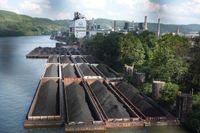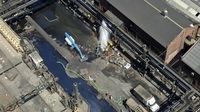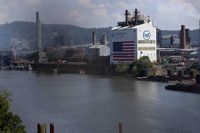The small city of Clairton, Pennsylvania, was rocked on August 11, 2025, by a devastating explosion at the U.S. Steel Clairton Coke Works plant—a tragedy that left two workers dead, more than ten injured, and a tight-knit industrial community grappling with shock and grief. The incident, which unfolded just after 10:50 a.m., sent tremors through nearby neighborhoods and set off a massive emergency response, highlighting both the dangers inherent in heavy industry and the resilience of those who work within it.
According to the Associated Press, the blast occurred inside a battery operating area at the sprawling facility, which sits about 15 miles southeast of Pittsburgh along the Monongahela River. The plant is the largest coking operation in North America, employing some 1,400 people and serving as one of four major U.S. Steel plants in Pennsylvania. On that fateful Monday morning, routine operations gave way to chaos as an explosion—followed by what many initially believed were multiple secondary blasts—trapped workers beneath smoldering rubble and sent a plume of black smoke into the sky.
Allegheny County officials later clarified, as reported by WHYY News, that two loud booms after the initial explosion were actually the activation of relief pressure valves—a safety mechanism designed to vent dangerous gases and prevent further catastrophe. Nonetheless, the force of the blast was enough to shake homes in the surrounding Mon Valley community, prompting urgent warnings for residents to stay clear of the area so first responders could do their work.
Emergency personnel, including company firefighters, local responders, and members of Pennsylvania Urban Search & Rescue, raced to the scene. The rescue effort was harrowing. One worker was pulled alive from the debris and rushed to the hospital, while teams stabilized a precarious wall and used advanced cameras to search for a missing colleague. Tragically, that worker was later found dead amid the wreckage. In total, ten people were injured in addition to the deceased; five remained in critical but stable condition as of the following day, according to the Allegheny County Police Department. Five others were treated and released.
The names and stories of the victims quickly became central to the community’s mourning. One of the deceased was identified as Timothy Quinn, a 39-year-old father of three. Governor Josh Shapiro, who visited with Quinn’s family and other affected workers, described him as a devoted parent and a “mama’s boy” who cared deeply for his children, his mother, and his girlfriend’s two kids. Shapiro told reporters, “His life was cut too short because of what happened here at this plant. We have a responsibility to remember his legacy, to make sure his memory lives on.” The second victim’s name was withheld at the request of their family.
David B. Burritt, president and CEO of U.S. Steel, issued a somber statement: “We are working closely with relevant authorities to investigate the cause of the incident. Nearly 1,300 dedicated men and women work at the Clairton Plant each day, performing their jobs with the utmost safety. During times like this, U.S. Steel employees come together to extend their love, prayers, and support to everyone affected.” He called it an “extraordinarily difficult day” for the U.S. Steel family, vowing to cooperate fully with all investigations and to take every step necessary to ensure worker safety going forward.
The plant, which processes raw coal into coke—a crucial ingredient in steelmaking—has a storied but troubled history. The coking process involves baking coal in special ovens at extremely high temperatures, which removes impurities but also produces coke gas, a hazardous blend of methane, carbon dioxide, and carbon monoxide. This inherent danger has resulted in a series of past accidents: in 2009, a maintenance worker was killed in an explosion; in 2010, another blast injured fourteen employees and six contractors, leading to $175,000 in Occupational Safety and Health Administration (OSHA) fines for safety violations. The last fatality before this week occurred in 2014, when a worker died after falling into a trench and being burned. As recently as February 2025, a buildup of combustible material caused a fire and minor injuries for two workers.
Local residents are no strangers to the risks. Deanna Forkey, who works at a nearby deli frequented by plant employees, told the Associated Press, “Explosions over there aren’t really uncommon. We hear them a lot. But that one obviously was much worse.” Her sentiment is echoed by many in Clairton, a city whose identity and economy have long been intertwined with steel production but whose patience for industrial accidents is wearing thin.
Environmental concerns have also shadowed the Clairton plant for years. After Monday’s explosion, the Allegheny County Health Department issued an air quality advisory for residents within a mile of the facility, urging them to stay indoors and close windows. By Monday night, the advisory was lifted after air monitors detected no rise in fine particulate matter (PM 2.5) or sulfur dioxide above federal standards. Still, memories linger of a 2018 Christmas Eve fire that damaged pollution control equipment, resulting in weeks of poor air quality and a subsequent lawsuit. U.S. Steel ultimately agreed to spend nearly $25 million on equipment upgrades and local clean air initiatives. Dr. Deborah Gentile, a local asthma specialist, found that asthma-related medical visits doubled in the aftermath of that earlier incident.
The broader context of this tragedy is the recent transformation of U.S. Steel itself. Once the undisputed titan of American industry, the company was acquired in June 2025 by Nippon Steel—Japan’s largest steelmaker—in a nearly $15 billion deal. The merger, which faced obstacles related to national security and politics in a key battleground state, created the world’s fourth-largest steelmaker. The agreement includes a “golden share” provision, giving the U.S. government the power to appoint a board member and influence decisions on domestic steel production and competition with foreign producers.
As the investigation into the cause of the explosion proceeds, officials, union leaders, and community members are united in their demand for answers and accountability. Governor Shapiro said, “We owe them the answers to their questions, and we owe them to never forget the sacrifices that occurred here yesterday.” Allegheny County Executive Sara Innamorato added, “We all share a common goal. We want to get to the bottom of what happened, and we want to prevent it from happening ever again.”
For Clairton and the wider Mon Valley, the path forward will require not only technical fixes and regulatory scrutiny but also a renewed commitment to the safety and dignity of the workers who keep this storied industry alive. The legacy of those lost—and the resolve of those who remain—will shape the next chapter for Pennsylvania steel.




